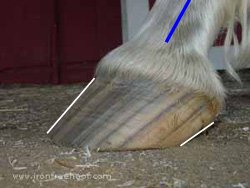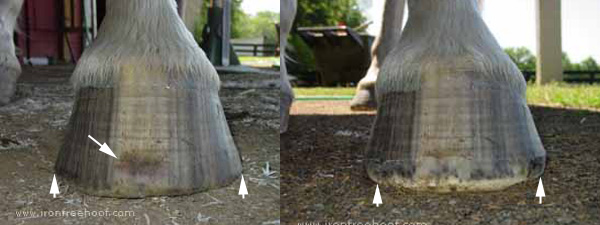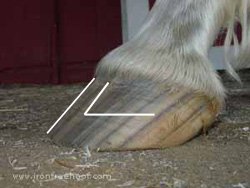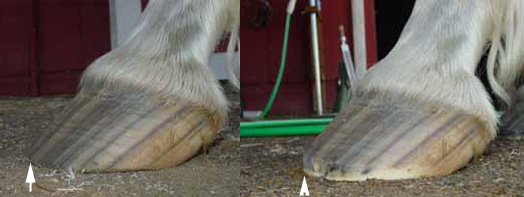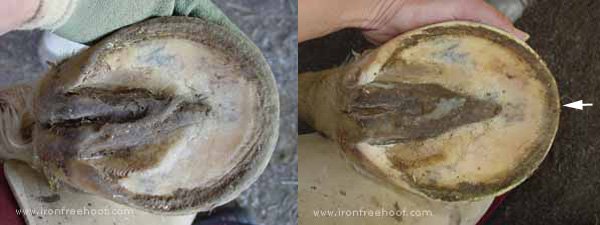|
Long Toe / Under-run HeelsThe long toe on this hoof wants to grow forward and the heels want to under-run. There are a host of problems with this foot. I am not going to be able to fix them in a trim. This is an example page that is not a complete case study. I want to just show you how I would look at and trim this foot on this day, so I will go through the steps I use when trimming. This is an Andalusian gelding that is ridden extensively.
Lateral View 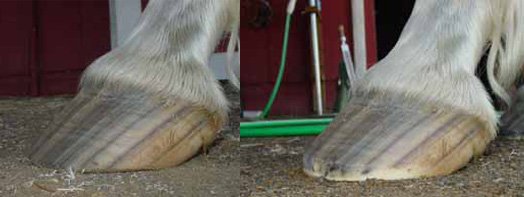
My first impression of this foot is that the toe is running forward and that the heels want to under-run.
I hope the lines make it easier to see what I am seeing. My impression is that this foot is shooting forward. I didn't take a great picture of the pastern. I hate it when that happens. But, what the blue line is showing is a rough angle of the pastern. Notice that the front of the hoof wall slopes more than the pastern. That really is true for this horse and is not just the way he is standing in this picture. The heels also want to grow forward. This is commonly called under-run. Long Toe and Balance
When I look at the balance of this hoof, I think it is pretty good from side to side. The arrows are pointing out where weight bearing is before and after the trim. My mustang roll has collected this hoof and made the inner hoof wall the weight bearing surface. This is how I keep distortion to a minimum. The arrow at the toe is showing a bruise that has grown down from the coronary band. The owner used Boa boots on him about six months before and they rubbed the coronary band and caused this bruise in both front feet. Long Toe and the Coffin Bone
When I try to visualize where the coffin bone is in this foot, I think that the wall is pulling away and is not perfectly lined up. Sometimes coffin bones are sharper and will be shaped like this hoof, but rarely. Since, that is a possibility, that is why I don't insist the foot comes back all in one trim. Long Toe and a Mustang Roll
When I decide my priorities, bringing the toe back is the highest. I know many would bring the heels back further, but I don't at this point in the game. If I bring them back further, I will have to lower them. If I lower them, it will cause the toe to shoot forward more. In my experience, making sure the heels are weight bearing at the strong part and keeping them as high as possible works the best at getting feet like this to quit running forward. Bottom of the Hoof
Can you see that I have rolled the wall right up to the white line at the toe? The rest of the hoof has a little wall (inner hoof). I have found that rolling to the white line in this one portion of the hoof helps to keep hoof capsules from gravitating forward in between trims. If the owner is going to trim for themselves and can lightly rasp the toe back, then this is not a necessary step. In my own riding mare, I like to leave her more toe, but I do more of an owner trim on her. If I know I am not going to trim her for 4 to 6 weeks, then I will roll her toe back this far too. Trimming this horse has very much been a process. While these hooves may look distorted, they have changed dramatically for the best. He has gotten more comfortable and is his ringbone is no longer bothering him. It has been a combination of trimming, exercise and dietary changes that have facilitated the changes. It has not been trimming alone.
Return from an example of a long toe to the trimming page. Return to Iron Free Hoof home |
